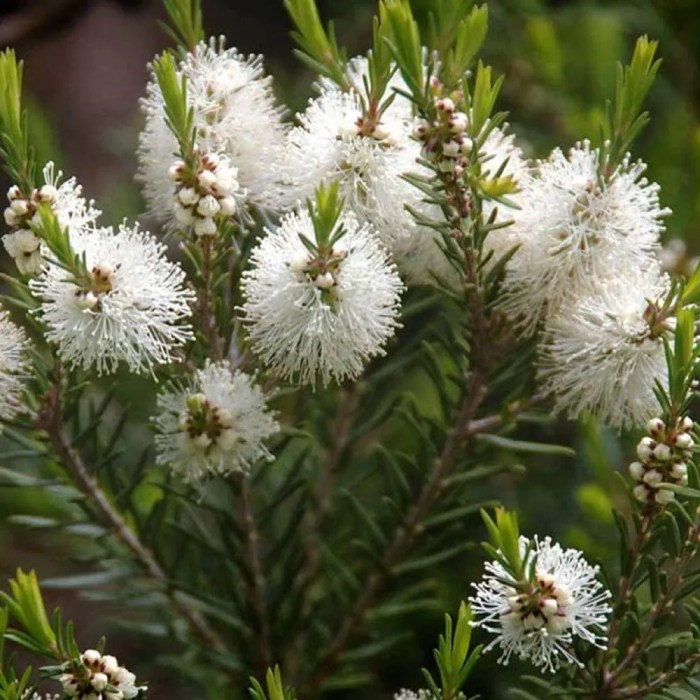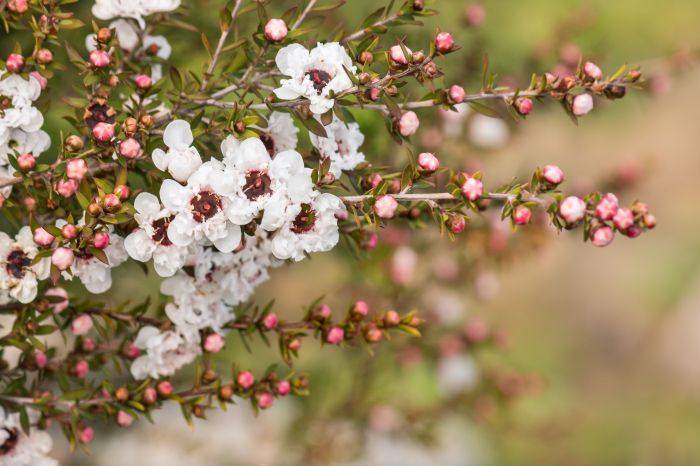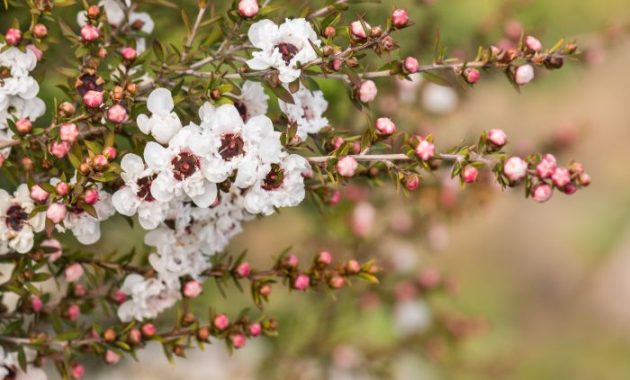Tea Tree Plant Identification
Tea tree plant picture – The tea tree,Melaleuca alternifolia*, is a small to medium-sized tree native to eastern Australia, prized for its essential oil with potent antimicrobial properties. Accurate identification is crucial, particularly for those harvesting the leaves for commercial purposes, as misidentification can lead to the use of plants with different chemical compositions and potentially harmful effects. Careful observation of several key characteristics is essential for reliable identification.
Physical Characteristics of the Tea Tree Plant
The tea tree typically grows to a height of 2 to 8 meters, exhibiting a somewhat irregular, spreading growth habit. Its bark is thin, papery, and sheds in strips, revealing a smooth, light grey-brown underbark. The leaves are the most distinctive feature, being lanceolate to ovate, 1 to 3.5 centimeters long, and 0.2 to 1 centimeter wide. They are alternate, simple, and possess a characteristic strong, pungent aroma when crushed.
The flowers are small, creamy white, and arranged in dense cylindrical spikes at the ends of branches. These spikes are typically 2 to 5 centimeters long and are composed of numerous individual flowers.
Comparison with Similar-Looking Plants
Several plants share superficial similarities with the tea tree, leading to potential confusion. Distinguishing features include the specific leaf arrangement, aroma, and bark characteristics. For instance,
- Leptospermum* species, often called tea trees as well, possess similar leaves but lack the characteristic strong aroma of
- Melaleuca alternifolia*. Furthermore, certain
- Eucalyptus* species exhibit a similar leaf shape, but their bark is distinctly different, often rough and fibrous. Careful examination of all features, including the overall plant structure, leaf arrangement, bark texture, and the aroma of crushed leaves, is necessary for accurate identification.
Leaf Morphology Comparison
The following table compares the leaf morphology ofMelaleuca alternifolia* with three other similar-looking plants. These differences highlight the importance of careful observation for accurate identification.
| Plant Species | Leaf Shape | Leaf Size (cm) | Leaf Texture | Aroma |
|---|---|---|---|---|
| Melaleuca alternifolia (Tea Tree) | Lanceolate to ovate | 1-3.5 x 0.2-1 | Leathery, slightly stiff | Strong, pungent, medicinal |
| Leptospermum laevigatum (Coastal Tea Tree) | Lanceolate to ovate | 0.5-2 x 0.2-0.5 | Leathery | Mild, slightly aromatic |
| Eucalyptus radiata (Narrow-leaved Peppermint) | Lanceolate | 5-15 x 0.5-1 | Leathery, slightly stiff | Pepperminty, camphoraceous |
| Callistemon citrinus (Crimson Bottlebrush) | Linear to lanceolate | 3-7 x 0.3-0.5 | Leathery | Slightly citrusy |
Tea Tree Plant Habitat and Cultivation

The cultivation ofMelaleuca alternifolia*, commonly known as the tea tree, requires a nuanced understanding of its environmental needs. Successful growth hinges on replicating its native Australian habitat, a balance of specific soil conditions, climate, and sunlight exposure. Deviation from these ideal parameters can significantly impact plant health and yield.
Tea tree thrives in a relatively narrow range of environmental conditions. Understanding these requirements is crucial for optimizing growth and maximizing the yield of essential oils, the plant’s primary economic value.
Ideal Environmental Conditions
Tea tree prefers well-drained, slightly acidic soils (pH 4.5-6.5) with high organic matter content. Heavy clay soils, prone to waterlogging, are detrimental to root health. Sandy loam soils, providing excellent drainage and aeration, are generally considered ideal. Consistent moisture is necessary, but excessive watering can lead to root rot. The plant requires ample sunlight, ideally six to eight hours of direct sunlight per day, although some shade tolerance is exhibited in hotter climates.
The stark, almost medicinal green of the tea tree plant picture reminded me of something else entirely: the vibrant, almost impossibly lush leaves of a money tree. If you’re looking for a similar, but more prosperous, visual, you should check out the options for buying a money tree plant online ; they offer a completely different aesthetic, yet share that same captivating intensity of green.
Returning to the tea tree, though, I found myself appreciating its simpler beauty.
Tea tree is adapted to a subtropical climate, characterized by warm temperatures and moderate rainfall. Frost can severely damage or kill the plant, highlighting the importance of a frost-free environment.
Propagation Methods
Propagation of tea tree can be achieved through both cuttings and seeds. Each method presents distinct advantages and disadvantages.
Choosing the appropriate propagation method depends on several factors, including the desired scale of cultivation, the availability of planting material, and the desired genetic uniformity.
- Cuttings: This method offers faster establishment and maintains the genetic characteristics of the parent plant. Stem cuttings, typically taken from healthy, actively growing shoots, are rooted in a suitable medium, such as a mixture of perlite and vermiculite, under humid conditions. Root development typically occurs within several weeks. This is the preferred method for commercial cultivation.
- Seeds: Seed propagation is less commonly used commercially due to its slower growth rate and the potential for genetic variability. Seeds are collected from mature seed capsules and sown in a well-drained seedbed. Germination rates can be variable and depend on factors such as seed viability and environmental conditions. This method is more suitable for research or breeding programs seeking genetic diversity.
Pest and Disease Management, Tea tree plant picture
Tea tree cultivation can be challenged by various pests and diseases. Early detection and prompt intervention are crucial to minimize their impact on plant health and yield.
Effective pest and disease management relies on a combination of preventative measures and targeted treatments. Integrated pest management (IPM) strategies, incorporating both biological and chemical controls, are increasingly employed to minimize environmental impact while maintaining effective control.
- Pests: Common pests include scale insects, spider mites, and various leaf-eating insects. Regular monitoring and the use of appropriate insecticides, when necessary, can effectively manage pest populations. Biological control methods, such as the introduction of beneficial insects, can also be effective.
- Diseases: Fungal diseases, such as root rot and leaf spot, are significant concerns. Good sanitation practices, such as removing infected plant material and ensuring adequate soil drainage, are essential preventative measures. Fungicides may be applied as a last resort, but their use should be carefully considered to minimize environmental impact.
Tea Tree Plant Uses and Applications

The tea tree plant,Melaleuca alternifolia*, boasts a rich history of use, its essential oil prized for its potent antimicrobial properties. Indigenous Australians have utilized its leaves for centuries, applying them topically to treat wounds and skin ailments. This traditional knowledge forms the foundation for the plant’s modern applications across diverse industries.
Beyond its historical significance, tea tree oil has become a staple ingredient in numerous modern products. Its versatility stems from its broad-spectrum antimicrobial activity against bacteria, fungi, and viruses, coupled with its relatively low toxicity when used appropriately. This has led to its widespread adoption in cosmetics, pharmaceuticals, and cleaning products, offering consumers a natural alternative to synthetic compounds.
Traditional and Historical Uses of Tea Tree Oil
Early applications of tea tree leaves and oil centered on wound care and the treatment of minor skin infections. Indigenous Australians crushed the leaves and applied them directly to wounds, burns, and skin irritations. This practice highlighted the oil’s natural antiseptic and healing properties, demonstrating its effectiveness in promoting wound healing and preventing infection. Ethnobotanical studies continue to validate these traditional uses, confirming the antimicrobial potency of the oil and supporting its role in traditional medicine.
Modern Applications of Tea Tree Oil in Various Industries
The antimicrobial and antiseptic properties of tea tree oil have propelled its use in a wide range of modern applications. In the cosmetics industry, it’s a frequent ingredient in acne treatments, anti-dandruff shampoos, and skincare products designed to address various skin conditions. The pharmaceutical industry utilizes tea tree oil in topical ointments and creams for wound healing and the treatment of fungal infections like athlete’s foot.
Moreover, its antimicrobial properties make it a valuable component in various cleaning products, offering a natural and effective alternative to harsh chemical disinfectants. For example, tea tree oil is increasingly found in household cleaners, laundry detergents, and air fresheners.
Applications and Benefits of Tea Tree Oil
| Application Area | Specific Application | Key Benefits | Examples |
|---|---|---|---|
| Cosmetics | Acne treatments, shampoos, skincare products | Reduces acne, soothes irritated skin, combats dandruff | Facial cleansers containing tea tree oil, anti-dandruff shampoos with tea tree oil extract |
| Pharmaceuticals | Topical ointments, creams for wound healing and fungal infections | Promotes wound healing, treats fungal infections, reduces inflammation | Ointments for minor burns and cuts containing tea tree oil, antifungal creams for athlete’s foot |
| Cleaning Products | Household cleaners, laundry detergents, air fresheners | Disinfects surfaces, eliminates odors, provides a natural cleaning alternative | All-purpose cleaners incorporating tea tree oil, laundry detergents with tea tree oil for freshness |
| Personal Care | Mouthwashes, deodorants | Improves oral hygiene, reduces body odor | Mouthwashes with tea tree oil for gingivitis prevention, natural deodorants with tea tree oil |
Commonly Asked Questions: Tea Tree Plant Picture
Is tea tree oil safe for everyone?
No. Tea tree oil can cause skin irritation or allergic reactions in some individuals. Always perform a patch test before widespread use.
Can I grow a tea tree plant from a cutting?
Yes, propagation from cuttings is a common and successful method. Use semi-hardwood cuttings and ensure proper rooting hormone and environmental conditions.
What are the best uses of tea tree oil for skin?
Tea tree oil possesses antiseptic properties and is often used topically to treat minor cuts, acne, and fungal infections. However, dilution is crucial to avoid irritation.
Where is the tea tree plant native to?
The tea tree plant,
-Melaleuca alternifolia*, is native to eastern Australia.

